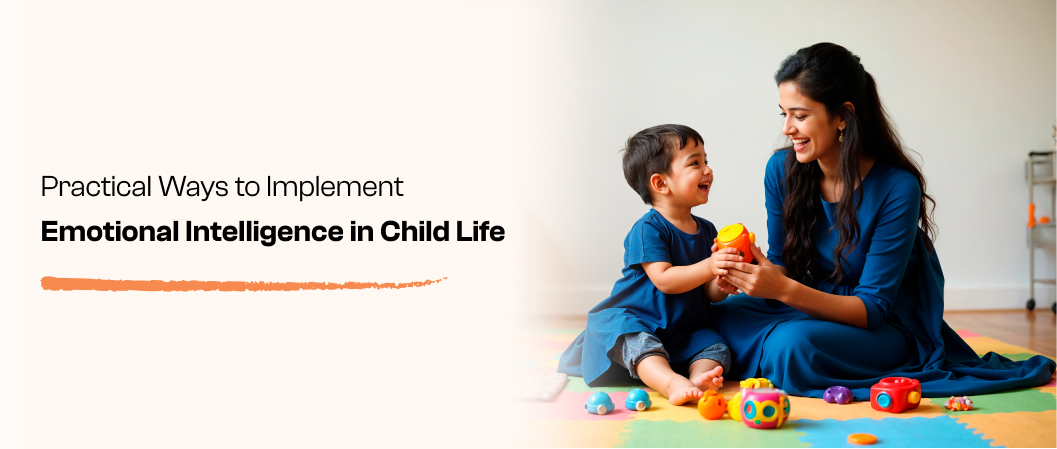Every child is unique, and we know learning isn’t only about books and exams. In our everyday lives, watching a kid smile when they understand a new feeling or manage a small upset shows us that teaching emotional intelligence (EI) is very important. Emotional intelligence helps children figure out what they feel and why so they can handle their ups and downs more easily. This guide is meant to be a friendly, practical roadmap for parents and educators to help children grow emotionally, step by step.
Understanding Emotional Intelligence
Emotional intelligence is understanding what we feel and why we feel. It means recognizing our emotions and being aware of the feelings of people around us. We often see that when kids learn to express their emotions—happy, sad, or frustrated—they manage their feelings better. They learn that it’s okay to be upset sometimes and that sharing their feelings can help them feel better. Over time, these skills build a strong foundation for handling the real challenges of life.
Why Teach Emotional Intelligence to Children
With heavy homework loads, school competitions, and the constant buzz of smartphones, our kids often get overwhelmed. Teaching emotional intelligence gives them a way to understand their feelings, and it helps them deal with stress in a positive manner.
We see in many classrooms that when kids learn to manage their emotions, they are calmer and more focused. They handle conflicts better and build healthier relationships with friends and teachers. In simple terms, nurturing EI is as important as learning math or science—it equips children with the skills they need to face life confidently.
Teaching EI also means preparing our kids to be empathetic. When they learn to put themselves in someone else’s shoes, they become more thoughtful and kind.
Practical Ways to Implement Emotional Intelligence in Child Life
Below are 13 practical and innovative ways to help your child develop emotional intelligence. These ideas have been shared by many families and educators across our communities, and they have proven to be effective in nurturing a child’s emotional growth.
1. Emotion Naming Games
One of the simplest ways to start is by playing emotion-naming games. During everyday moments like dinner or playtime, ask your child, “How do you feel right now?” Let them answer in simple words like “happy,” “sad,” “angry,” or “excited.” This small game helps them learn that every emotion is different and that feeling mixed sentiments is ok. Over time, these moments become a natural part of their daily routine.
2. Storytelling with Emotions
We all love stories, and they can teach a lot about feelings. Choose a story or a fable where characters experience different emotions. While reading, pause to ask, “How do you think the character felt when that happened?” or “What would you have done differently?” It makes storytime interactive and helps children understand that emotions are a part of everyone’s life.
3. Mindful Breathing
You know what? A simple breath can change everything. Teach your child a mindful breathing exercise: Take a deep breath in through the nose, hold it for a moment, and then slowly breathe out through the mouth. Practice together during calm moments or when your child seems a bit upset. Over time, this habit can help them manage stress better by simply using their breath as a tool to reset their emotions.
4. Role-Playing Real-Life Situations
Roleplaying can be a fun way to learn. Create small scenarios at home that mimic everyday challenges—maybe a situation where a friend doesn’t share a toy or a small argument arises. Act out these situations together and discuss different ways to respond. This exercise not only teaches kids how to deal with conflicts but also shows them that there are many ways to solve a problem.
5. Keeping a Gratitude Journal
A gratitude journal is a simple tool that can make a big difference. Encourage your child to keep a small notebook where they write or draw things they are thankful for every day. This practice shifts their focus to positive experiences, helping them see the good even on tough days. It’s a quiet time when they learn to appreciate little moments of joy.
6. Expressing Through Art and Music
Not every emotion can be easily explained with words. A child expresses their feelings better through art or music. Encourage them to draw, paint, or even dance. Creative activities allow children to process emotions in a fun and natural way. Whether it’s drawing a picture of a sunny day when they’re happy or doodling when they’re upset, these creative outlets can be very soothing.
7. Daily Emotion Check-Ins
Make it a habit to have a short conversation about emotions every day. It might be during bedtime or over a meal. Ask, “What was the best part of your day?” or “Did anything make you feel a little sad today?” Regular check-ins help children get used to talking about their feelings and make them feel heard and understood.
8. Positive Affirmations
Positive words have a powerful effect on our minds. Teach your child simple affirmations like “I am brave” or “I can handle this.” Repeating these phrases every day can boost their self-esteem and help them face challenges with a positive mindset. Over time, these affirmations become part of their inner dialogue, reinforcing a strong and resilient self-image.
9. Practicing Conflict Resolution
Conflicts are a normal part of life, even for children. Set up small role-playing exercises where your child can practice resolving disagreements. For example, simulate a scenario where two friends want the same toy and talk through a calm solution. This exercise helps them learn that every conflict has a solution and that speaking calmly and listening to others can make all the difference.
10. Modeling Healthy Emotional Behavior
Children watch what we do more than what we say. By modeling healthy emotional behavior—like taking a moment to breathe when stressed or talking about our feelings openly—we set an example for our children. When they see us positively managing our emotions, they learn to do the same. It’s about showing, not just telling.
11. Group Activities and Teamwork
Encouraging your child to join group activities such as sports, dance, or cultural clubs can teach them a lot about teamwork and cooperation. In a group, every child learns the importance of teamwork. They understand that every voice matters and that sharing responsibilities can lead to better results. These experiences build strong social skills and a sense of community.
12. Reflective Conversations
After an incident where emotions ran high, take a little time to sit with your child and talk about what happened. Ask gentle questions like, “How did that make you feel?” and “What could we do differently next time?” Such reflective conversations help children learn from their experiences and gradually become better at handling similar situations in the future.
13. Setting Small Emotional Goals
Finally, help your child set small, achievable goals related to managing their emotions. It might be something simple, like remembering to take three deep breaths when upset or saying something kind when they’re frustrated. Celebrate these small wins together, as every step counts. These goals are not about perfection but about steady, everyday improvement.
All these 13 ways are like little building blocks. When we put them together, they form a strong foundation of emotional intelligence in our children.
Conclusion
Teaching emotional intelligence is a gift that keeps on giving. In today’s world, where our children face both academic pressures and the distractions of modern life, nurturing EI is essential. By helping our kids understand and express their emotions, we prepare them to face challenges with courage and compassion. As parents, teachers, and community members, we all play a role in this journey. By implementing these strategies, our children will grow up smart, kind, resilient, and emotionally aware.
Keep reading about
Recent Post

Leadership Skills for Teenagers: 5 Essential Traits to Master Before Turning 18
Read More







